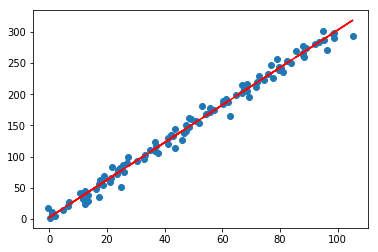《机器学习_01_线性模型_线性回归_正则化(Lasso,Ridge,ElasticNet)》
一.过拟合
建模的目的是让模型学习到数据的一般性规律,但有时候可能会学过头,学到一些噪声数据的特性,虽然模型可以在训练集上取得好的表现,但在测试集上结果往往会变差,这时称模型陷入了过拟合,接下来造一些伪数据进行演示:
import os
os.chdir('../')
from ml_models.linear_model import *
import numpy as np
import matplotlib.pyplot as plt
%matplotlib inline
#造伪样本
X=np.linspace(0,100,100)
X=np.c_[X,np.ones(100)]
w=np.asarray([3,2])
Y=X.dot(w)
X=X.astype('float')
Y=Y.astype('float')
X[:,0]+=np.random.normal(size=(X[:,0].shape))*3#添加噪声
Y=Y.reshape(100,1)
#拟合数据并可视化
lr=LinearRegression()
lr.fit(X[:,:-1],Y)
lr.plot_fit_boundary(X[:,:-1],Y)

目前看起来效果还是可以的,但如果加入几个异常点,再看看效果呢
X=np.concatenate([X,np.asanyarray([[100,1],[101,1],[102,1],[103,1],[104,1]])])
Y=np.concatenate([Y,np.asanyarray([[3000],[3300],[3600],[3800],[3900]])])
lr=LinearRegression()
lr.fit(X[:,:-1],Y)
lr.plot_fit_boundary(X[:,:-1],Y)

二.正则化
可以看到,仅仅加入了几个很离谱的异常点,就会对预测产生很大的影响,且偏离很远,这在实际情况中是很常见的;通常可以通过对模型参数添加正则化约束来避免这种情况,使其不会太“飘”,做法是在loss函数中为权重\(w\)添加\(L_1\)或者\(L_2\)约束,借用上一节的公式推导,直接推出loss部分:
1.线性回归中添加\(L_1\)约束称为Lasso回归,其损失函数如下:
\]
2.线性回归中添加\(L_2\)约束称为Ridge回归,其损失函数如下:
\]
3.如果不太确定用\(L_1\)好,还是\(L_2\)好,可以用它们的组合,称作ElasticNet,损失函数如下:
\]
可以发现通过调整超参,可以控制\(w\)的大小,如果\(\lambda\)或\(\alpha\)设置很大,\(w\)会被约束的很小,而如果\(\alpha\)或\(\lambda\)设置为0,等价于原始的不带正则项的线性回归;通常可以通过交叉验证,根据验证集上的表现来设置一个合适的超参;接下来在上一节线性回归代码的基础上实现Lasso,Ridge,ElasticNet模型,另外设置两个参数l1_ratio以及l2_ratio,分别用来控制\(L_1\)和\(L_2\)的loss部分的权重
三.代码实现
class LinearRegression(object):
def __init__(self, fit_intercept=True, solver='sgd', if_standard=True, epochs=10, eta=1e-2, batch_size=1,
l1_ratio=None, l2_ratio=None):
"""
:param fit_intercept: 是否训练bias
:param solver:
:param if_standard:
"""
self.w = None
self.fit_intercept = fit_intercept
self.solver = solver
self.if_standard = if_standard
if if_standard:
self.feature_mean = None
self.feature_std = None
self.epochs = epochs
self.eta = eta
self.batch_size = batch_size
self.l1_ratio = l1_ratio
self.l2_ratio = l2_ratio
# 注册sign函数
self.sign_func = np.vectorize(utils.sign)
def init_params(self, n_features):
"""
初始化参数
:return:
"""
self.w = np.random.random(size=(n_features, 1))
def _fit_closed_form_solution(self, x, y):
"""
直接求闭式解
:param x:
:param y:
:return:
"""
if self.l1_ratio is None and self.l2_ratio is None:
self.w = np.linalg.pinv(x).dot(y)
elif self.l1_ratio is None and self.l2_ratio is not None:
self.w = np.linalg.inv(x.T.dot(x) + self.l2_ratio * np.eye(x.shape[1])).dot(x.T).dot(y)
else:
self._fit_sgd(x, y)
def _fit_sgd(self, x, y):
"""
随机梯度下降求解
:param x:
:param y:
:param epochs:
:param eta:
:param batch_size:
:return:
"""
x_y = np.c_[x, y]
# 按batch_size更新w,b
for _ in range(self.epochs):
np.random.shuffle(x_y)
for index in range(x_y.shape[0] // self.batch_size):
batch_x_y = x_y[self.batch_size * index:self.batch_size * (index + 1)]
batch_x = batch_x_y[:, :-1]
batch_y = batch_x_y[:, -1:]
dw = -2 * batch_x.T.dot(batch_y - batch_x.dot(self.w)) / self.batch_size
# 添加l1和l2的部分
dw_reg = np.zeros(shape=(x.shape[1] - 1, 1))
if self.l1_ratio is not None:
dw_reg += self.l1_ratio * self.sign_func(self.w[:-1]) / self.batch_size
if self.l2_ratio is not None:
dw_reg += 2 * self.l2_ratio * self.w[:-1] / self.batch_size
dw_reg = np.concatenate([dw_reg, np.asarray([[0]])], axis=0)
dw += dw_reg
self.w = self.w - self.eta * dw
def fit(self, x, y):
# 是否归一化feature
if self.if_standard:
self.feature_mean = np.mean(x, axis=0)
self.feature_std = np.std(x, axis=0) + 1e-8
x = (x - self.feature_mean) / self.feature_std
# 是否训练bias
if self.fit_intercept:
x = np.c_[x, np.ones_like(y)]
# 初始化参数
self.init_params(x.shape[1])
# 训练模型
if self.solver == 'closed_form':
self._fit_closed_form_solution(x, y)
elif self.solver == 'sgd':
self._fit_sgd(x, y)
def get_params(self):
"""
输出原始的系数
:return: w,b
"""
if self.fit_intercept:
w = self.w[:-1]
b = self.w[-1]
else:
w = self.w
b = 0
if self.if_standard:
w = w / self.feature_std.reshape(-1, 1)
b = b - w.T.dot(self.feature_mean.reshape(-1, 1))
return w.reshape(-1), b
def predict(self, x):
"""
:param x:ndarray格式数据: m x n
:return: m x 1
"""
if self.if_standard:
x = (x - self.feature_mean) / self.feature_std
if self.fit_intercept:
x = np.c_[x, np.ones(shape=x.shape[0])]
return x.dot(self.w)
def plot_fit_boundary(self, x, y):
"""
绘制拟合结果
:param x:
:param y:
:return:
"""
plt.scatter(x[:, 0], y)
plt.plot(x[:, 0], self.predict(x), 'r')
Lasso
lasso=LinearRegression(l1_ratio=100)
lasso.fit(X[:,:-1],Y)
lasso.plot_fit_boundary(X[:,:-1],Y)

Ridge
ridge=LinearRegression(l2_ratio=10)
ridge.fit(X[:,:-1],Y)
ridge.plot_fit_boundary(X[:,:-1],Y)

ElasticNet
elastic=LinearRegression(l1_ratio=100,l2_ratio=10)
elastic.fit(X[:,:-1],Y)
elastic.plot_fit_boundary(X[:,:-1],Y)

将sign函数整理到ml_models.utils中
《机器学习_01_线性模型_线性回归_正则化(Lasso,Ridge,ElasticNet)》的更多相关文章
- 简单物联网:外网访问内网路由器下树莓派Flask服务器
最近做一个小东西,大概过程就是想在教室,宿舍控制实验室的一些设备. 已经在树莓上搭了一个轻量的flask服务器,在实验室的路由器下,任何设备都是可以访问的:但是有一些限制条件,比如我想在宿舍控制我种花 ...
- 利用ssh反向代理以及autossh实现从外网连接内网服务器
前言 最近遇到这样一个问题,我在实验室架设了一台服务器,给师弟或者小伙伴练习Linux用,然后平时在实验室这边直接连接是没有问题的,都是内网嘛.但是回到宿舍问题出来了,使用校园网的童鞋还是能连接上,使 ...
- 外网访问内网Docker容器
外网访问内网Docker容器 本地安装了Docker容器,只能在局域网内访问,怎样从外网也能访问本地Docker容器? 本文将介绍具体的实现步骤. 1. 准备工作 1.1 安装并启动Docker容器 ...
- 外网访问内网SpringBoot
外网访问内网SpringBoot 本地安装了SpringBoot,只能在局域网内访问,怎样从外网也能访问本地SpringBoot? 本文将介绍具体的实现步骤. 1. 准备工作 1.1 安装Java 1 ...
- 外网访问内网Elasticsearch WEB
外网访问内网Elasticsearch WEB 本地安装了Elasticsearch,只能在局域网内访问其WEB,怎样从外网也能访问本地Elasticsearch? 本文将介绍具体的实现步骤. 1. ...
- 怎样从外网访问内网Rails
外网访问内网Rails 本地安装了Rails,只能在局域网内访问,怎样从外网也能访问本地Rails? 本文将介绍具体的实现步骤. 1. 准备工作 1.1 安装并启动Rails 默认安装的Rails端口 ...
- 怎样从外网访问内网Memcached数据库
外网访问内网Memcached数据库 本地安装了Memcached数据库,只能在局域网内访问,怎样从外网也能访问本地Memcached数据库? 本文将介绍具体的实现步骤. 1. 准备工作 1.1 安装 ...
- 怎样从外网访问内网CouchDB数据库
外网访问内网CouchDB数据库 本地安装了CouchDB数据库,只能在局域网内访问,怎样从外网也能访问本地CouchDB数据库? 本文将介绍具体的实现步骤. 1. 准备工作 1.1 安装并启动Cou ...
- 怎样从外网访问内网DB2数据库
外网访问内网DB2数据库 本地安装了DB2数据库,只能在局域网内访问,怎样从外网也能访问本地DB2数据库? 本文将介绍具体的实现步骤. 1. 准备工作 1.1 安装并启动DB2数据库 默认安装的DB2 ...
- 怎样从外网访问内网OpenLDAP数据库
外网访问内网OpenLDAP数据库 本地安装了OpenLDAP数据库,只能在局域网内访问,怎样从外网也能访问本地OpenLDAP数据库? 本文将介绍具体的实现步骤. 1. 准备工作 1.1 安装并启动 ...
随机推荐
- java 多线--静态代理模式
我们使用 java 多线程时,都需要通过线程代理对象来启动线程,常见的写法: new Thread(target).start(); 这在设计模式中叫静态代理模式,静态代理模式组成; 1.公共接口 2 ...
- 报错:require_once cannot allocate memory----php,以前自己弄的稍微有点特殊的开发环境
最近出现过一个问题,值得记录 类似于这样的报错的问题: Warning: require_once(/www/app/somecomponent.php): failed to open stream ...
- ES6让字符串String增加了哪些好玩的特性呢?
确实因为现在天气变热了,所以一天天的这么写我也很累.所以如果阅读的时候有什么错误还请大家指出来,不好意思.学习永无止境. OK,今天继续讲解ES6系列知识 学过上一节的解构赋值就知道,ES6确实给我们 ...
- 通过纯css实现图片居中的多种实现方式
html结构: <div class="demo" style="width: 800px;height: 600px; border:1px solid #ddd ...
- 2019-2020-1 20199325《Linux内核原理与分析》第四周作业
start_kernel函数的执行过程 asmlinkage __visible void __init start_kernel(void) { char *command_line; char * ...
- [Python] bytes 转换成 str
b = b"example" # bytes object s = "example" # str object sb = bytes(s, encoding ...
- poj_1323 Game Prediction 贪心
Game Prediction Time Limit: 1000MS Memory Limit: 10000K Total Submissions: 11814 Accepted: 5701 ...
- 浅析 JS 中的作用域链
作用域链的形成 在 JS 中每个函数都有自己的执行环境,而每个执行环境都有一个与之对应的变量对象.例如: var a = 2 function fn () { var a = 1 console.lo ...
- (原創) 如何在Nios II顯示8位數的七段顯示器? (SOC) (Nios II) (SOPC Builder) (DE2-70)
Abstract本文討論如何在Nios II控制8位數的七段顯示器. Introduction使用環境:Quartus II 8.0 + Nios II EDS 8.0 + DE2-70 (Cyclo ...
- 关于fastjson在序列化成JSON串时字段增加的问题
今天在项目中遇到控制器中返回的对象经过fastjsonMessageConverter转换后,前台收到的json中多了一个字段A的问题.而返回的这个对象中根本就没有定义这个字段A. 查了好久才发现对象 ...
